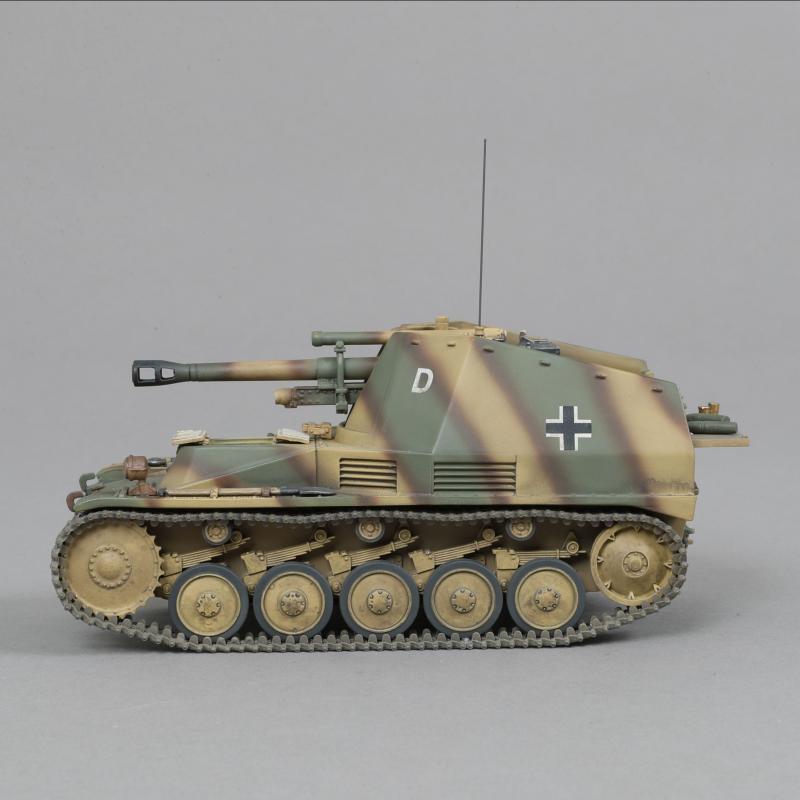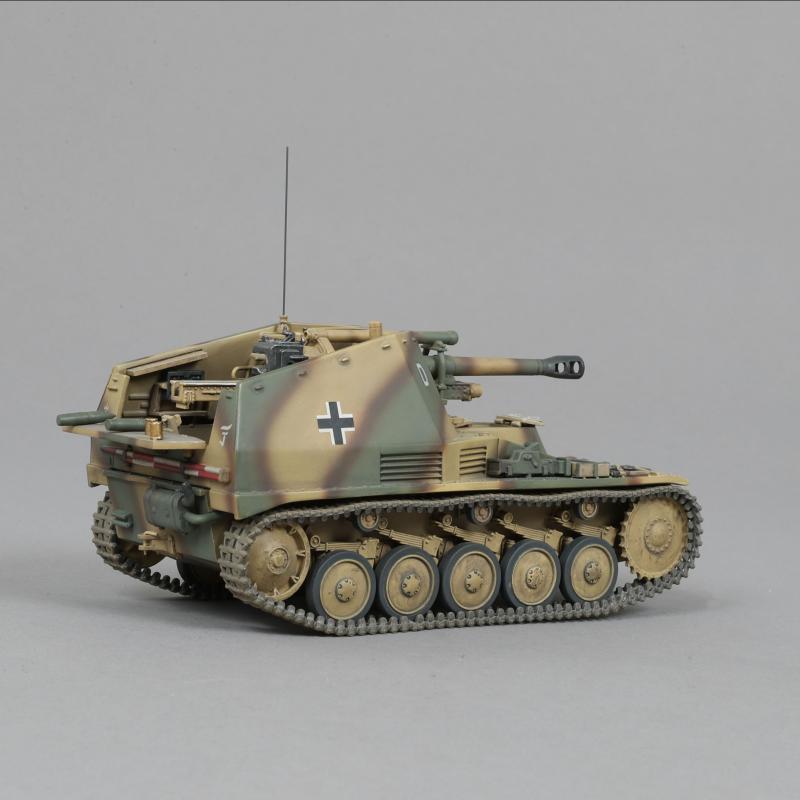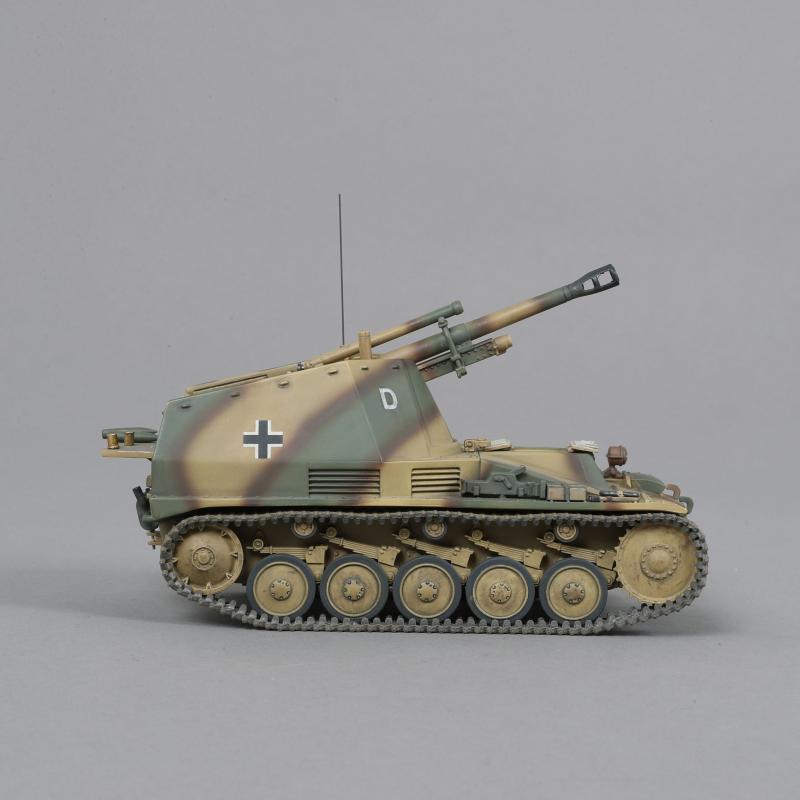The Sd.Kfz. 124 Wespe, "D"--TWO IN STOCK.
$299.00
Item Number: ACCPACK132
The Sd.Kfz. 124 Wespe, "D"
The Sd.Kfz. 124 Wespe
The Sd.Kfz. 124 Wespe (German for "wasp"), is a German SP Gun developed and used during the Second World War. It was based on a modified Panzer II chassis.
The Wespe SP gun SdKfz 165 was designed in 1942 to carry the 105mm FH18 gun into battle. Prior to its appearance, horses, half tracks, lorries, and pure brute strength were used to transport and position this large gun. The Wespe brought greater mobility to the artillery formations of the panzer divisions.
The Wespe proved reliable and highly manoeuvrable, but like contemporary SP guns such as the British Sexton and U.S. M7 Priest, had inadequate overhead gun crew protection. The Wespe was a considerably smaller target than either of these allied vehicles, but it also held less ammunition, given it was based on a smaller chassis, chosen based upon availability given limited production capacity for larger ones. Crews praised its reliability and mobility, but despised the lack of protection, both in thickness and height. The fighting compartment was also very cramped. The loaders working at the back end of the superstructure were the most exposed.
The Wespe SPG first saw action during operation Citadel on the Russian front in July 1943. It started to appear in growing numbers in the Panzer and Panzer Grenadier Divisions. They saw extensive service alongside the Hummel, first at Kursk, then with all three Eastern fronts groups. When the Allies landed in Normandy in 1944, Wespe SP guns were sent to the area to support counter-attacking German Panzer Divisions. It saw action in all the main theatres and battles after its introduction in 1943, including the Western Desert, Battle of the Bulge, Ukraine, Hungary, Italy, and Berlin. They were so successful that, after reading initial reports, Hitler ordered all other conversions based on the Panzer II chassis to be stopped and all work to go on the Wespe.
Weighing 11 tonnes (24,250 lb), armed with a 10.5 cm leFH 18/2 L/28 and a top speed of 40 kilometres per hour, it was relatively small vehicle, 4.81 metres [15ft 9in], 2.28 metres [7ft 6in] wide and 2.3 m [7ft 7in] in length. Especially with 5 crew, it must have been hard to see and even harder to hit. With a production run of 676 vehicles and such a widespread use in action, it is pretty amazing that in March 1945 there were still around 307 in active service.
The Wespe SP gun SdKfz 165 was designed in 1942 to carry the 105mm FH18 gun into battle. Prior to its appearance, horses, half tracks, lorries, and pure brute strength were used to transport and position this large gun. The Wespe brought greater mobility to the artillery formations of the panzer divisions.
The Wespe proved reliable and highly manoeuvrable, but like contemporary SP guns such as the British Sexton and U.S. M7 Priest, had inadequate overhead gun crew protection. The Wespe was a considerably smaller target than either of these allied vehicles, but it also held less ammunition, given it was based on a smaller chassis, chosen based upon availability given limited production capacity for larger ones. Crews praised its reliability and mobility, but despised the lack of protection, both in thickness and height. The fighting compartment was also very cramped. The loaders working at the back end of the superstructure were the most exposed.
The Wespe SPG first saw action during operation Citadel on the Russian front in July 1943. It started to appear in growing numbers in the Panzer and Panzer Grenadier Divisions. They saw extensive service alongside the Hummel, first at Kursk, then with all three Eastern fronts groups. When the Allies landed in Normandy in 1944, Wespe SP guns were sent to the area to support counter-attacking German Panzer Divisions. It saw action in all the main theatres and battles after its introduction in 1943, including the Western Desert, Battle of the Bulge, Ukraine, Hungary, Italy, and Berlin. They were so successful that, after reading initial reports, Hitler ordered all other conversions based on the Panzer II chassis to be stopped and all work to go on the Wespe.
Weighing 11 tonnes (24,250 lb), armed with a 10.5 cm leFH 18/2 L/28 and a top speed of 40 kilometres per hour, it was relatively small vehicle, 4.81 metres [15ft 9in], 2.28 metres [7ft 6in] wide and 2.3 m [7ft 7in] in length. Especially with 5 crew, it must have been hard to see and even harder to hit. With a production run of 676 vehicles and such a widespread use in action, it is pretty amazing that in March 1945 there were still around 307 in active service.
We have had this vehicle on our minds for a while now, now it has been finally released we are getting a bit of buzz.
Limited Availability.
Released in JULY 2025.


